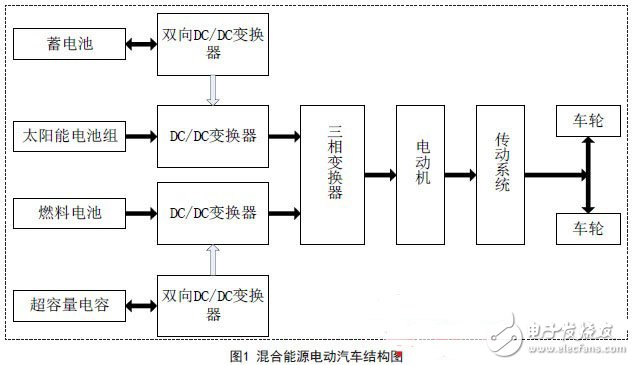1 Introduction
With the development of the economy, the number of cars has been increasing, and the problem of environmental pollution has become increasingly serious. Therefore, researching energy-saving, reducing emissions, protecting the environment of automobiles, and replacing green fuel vehicles with fuel vehicles is a need for a sustainable social development strategy and has become a common concern of all countries in the world. Electric air car is an ideal green car that saves fuel resources, reduces pollution and even zero emissions, and is the development direction of future cars. The earliest development is pure electric vehicles, but its charging facilities are not perfect, the mileage is limited, and there are also problems of difficult recycling and secondary pollution of used batteries. Under this background, hybrid electric vehicles have emerged.
2. Hybrid electric vehicle concept
Hybrid energy electric vehicles have the advantages of energy saving, environmental protection, unlimited mileage and no change in basic infrastructure. The most important thing is that the current technology is basically mature, and it is considered to be the most industrialized and market in current electric vehicles. One of the prospective models.
Its structure is shown in Figure 1.

3. Energy introduction
3.1 fuel cell + super capacitor
A fuel cell is an energy conversion device capable of continuously converting chemical energy into electrical energy through a redox reaction occurring at a cathode and an anode. As long as the oxidant and fuel are continuously supplied to the fuel cell, the electric energy can be continuously supplied, which is a difference from the conventional battery. Its advantages are as follows:
(1) Long working hours: The fuel cell has the advantages of long continuous working time and high energy conversion efficiency.
(2) Efficient: It does not pass the heat engine process and is not limited by the Carnot cycle. Its energy conversion efficiency is 40-60%. If the cogeneration is realized, the total fuel utilization rate can be as high as 80% or more.
(3) Environmentally friendly: When pure hydrogen is used as fuel, the chemical reactants of the fuel cell are only water, and the emission of carbon dioxide is greatly reduced, which plays an important role in relieving the greenhouse effect.
(4) Quiet: The fuel cell has few working parts and low noise during operation.
(5) High reliability: The fuel cell has experienced several types of development stages such as alkaline, phosphoric acid, molten carbonate and solid oxide. Its operation is very reliable and can be used as an uninterruptible power supply and various emergency power sources.
When the fuel cell starts up, the reaction speed is not as good as that of the internal combustion engine. If the reaction speed is increased, its stability must be ensured. It also has a relatively soft output characteristic, which leads to a decrease in efficiency. To solve this problem, a fuel cell and a DC/DC converter with a hard output characteristic are required to be integrated, and the vehicle is powered.
In order to solve the contradiction between the driving range of electric vehicles and the performance of accelerating climbing, it is possible to use the main energy-fuel cell to improve the optimal driving range, while the auxiliary energy-super capacitor provides short in acceleration and climbing. The auxiliary power of the time. The energy of the auxiliary energy system can be directly taken from the independent energy source, and the renewable kinetic energy can be recovered when the electric vehicle brakes or goes downhill. The supercapacitor has load balancing effect, and the discharge current of the fuel cell is reduced, so that the available energy and service life of the battery are significantly improved.
3.2 solar battery + battery
Solar energy is a renewable green energy source. Solar cells are an energy-saving and environmentally friendly battery that meets sustainable development. The installation of solar cells on the car body, the main goal is small quality, safety, minimal air resistance and maximum solar energy absorption. Currently widely used are crystalline silicon cells and thin film batteries, and their conversion efficiency and cost potential are shown in Table 1.

PLC splitter is a type of optical power management device that is fabricated using silica optical waveguide technology. It features small size, high reliability, wide operating wavelength range and good channel-to channel uniformity, and is widely used in PON networks to realize optical signal power splitting.
Bwinners provides whole series of 1×N and 2×N splitter products that are tailored for specific applications. All products meet GR-1209-CORE and GR-1221-CORE requirements. fiber optic splitter plc, fiber optic cable splitter, optical splitter , Mini Type PLC Splitter , Cassette Type PLC Splitter, Insertion Module PLC are available.
Features:
Low insertion loss and low PDL
Various coupling ratio
Environment stable
Single mode and multimode available
High Reliability and Stability
High Channel counts
Wide wavelength range
Customized packaging and configuration
Applications:
FTTx Construction
Fiber Optical communication system
Fiber Optical access networks
Fiber Sensor
Fiber CATV networks
Local area networks
Cassette Fiber Plc Splitter,Gpon Splitter Cassette,Plc Splitter Cassette Box,Optical Splitter Cassette Type
Sijee Optical Communication Technology Co.,Ltd , https://www.sijee-optical.com